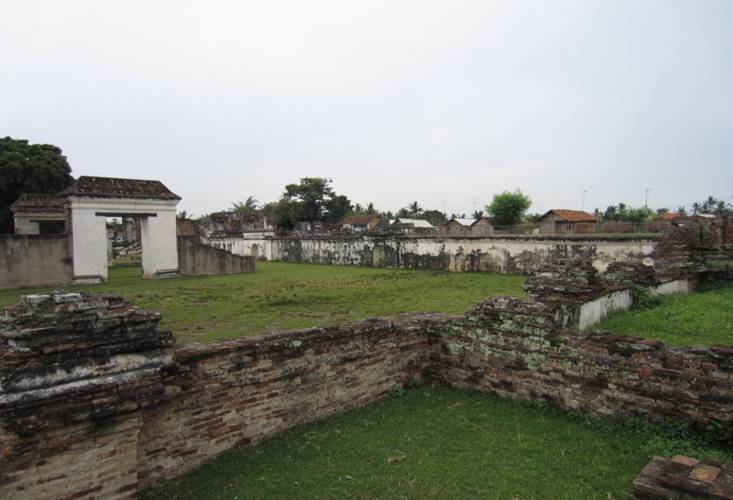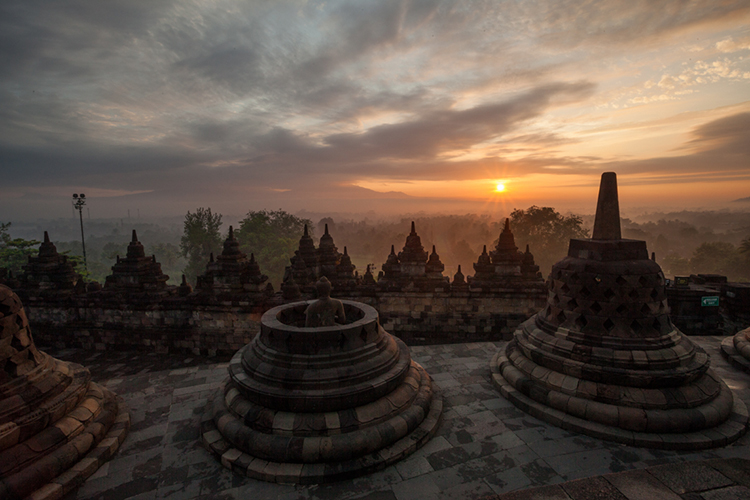When visitors take pictures of Indonesia, they tend to photograph Indonesia’s cultural heritage. They also often exclude people or represent them as bound by history and relics of a past era.
Tod Jones and Riwanto Tirtosudarmo
When visitors take pictures of Indonesia, they photograph Indonesia’s cultural heritage. These pictures share certain qualities. They seem harmonious and to be of activities or places that have remained the same for generations or centuries. They also often exclude people or represent them as bound by history and relics of a past era.
Conservation is really about change
This edition of Inside Indonesia is about the politics of these snapshots of contemporary Indonesia. Heritage is always changing, sometimes very quickly. It is as much about people as it is about places, objects and cultural practices. Indonesian heritage is also highly political. The appearance of an unchanging present tightly linked to the past is held together by powerful forces and interests ranging from family legacies and community bonds, to economic change (such as tourism), and international agreements. Conceived as a set of public resources that strengthen national or subnational solidarity and collective memory, heritage also involves the state, which will intervene when cultural citizenship is threatened. The line between state protection and private or community interests is hotly contested. Each article in this edition is itself a unique picture of the contemporary cultural politics of living with heritage in Indonesia.
The Heritage Issue
Every heritage issue is different, depending on both the configuration of relationships and the perspective of the author. Three of the articles in this edition share a common perspective. They are studies carried out over a three-year period as part of an Indonesian Institute of Sciences (LIPI) project on the politics of cultural heritage management at three of the most important archaeological sites in Indonesia. Dedi Supriadi Adhuri and Gutomo Bayu Aji discuss resident activism at Borobudur, Central Java. Sugih Biantoro writes about heritage controversies at Trowulan where the most extensive collection of Majapahit archaeological remains are located. Herry Yogaswara and Tine Suartina report how a intra-community division is affecting archaeologically diverse Banten-Lama that was once the location of a large Islamic Sultanate.
Borobudur temple - Credit: Political Economy of Heritage Project, courtesy of LIPI (Lembaga Ilmu Pengetahuan Indonesia)
The other articles are on a diverse range of topics by Indonesian and non-Indonesian authors. These include Daud Tanudirjo’s article on shifting approaches to Indonesian archaeology, Tod Jones’ article on the operation and effects of global UNESCO programs, Michael Romanos; article on a community program that revitalized a batik neighbourhood in Yogyakarta, Natali Pearson’s article on regulation of underwater heritage, and Graeme MacRae’s article on controversies around the World Heritage listing of the ‘Cultural Landscape of Bali’. They all share a critical perspective towards heritage and a commitment to understanding who wins and loses from heritage initiatives. In particular, they explore how local residents contest and make use of heritage.
Three heritage trends in Indonesia
Despite the differences between locations, there is a bigger picture demonstrated through shared themes across the articles in this edition. First, spatial management, in particular weak heritage planning legislation, is a major issue across Indonesia. Heritage legislation passed in 2010 has stalled due to the absence of implementing legislation, leaving heritage management frameworks weak and uncertain.
Second, decentralisation of political power has increased the power of local politicians and local elite. While some sites (like Borobudur and now Trowulan) fall under national legislation, most are controlled by local governments.
Third, residents and local groups are absent from the political elites’ considerations, but are also increasingly organising to assert their own interests. The politics of cultural heritage in Indonesia is intensifying, and local community engagements will increasingly establish links to national and international levels in order to push their agendas.
We would like to thank all of the contributors for their excellent and engaging articles. We are particularly grateful to Alexandra Crosby for her work editing the articles and checking and sourcing photographs. Thanks also to Nik Tan for his copy editing of the edition.
Tod Jones (T.Jones@curtin.edu.au) is a Senior Lecturer in Geography at Curtin University in Perth, Australia. His research interests are in Human Geography with a focus on heritage, cultural economics and cultural policy in Indonesia and Australia. His book, Culture, Power and Authoritarianism in the Indonesian State: Cultural Policy across the Twentieth Century to the Reform Era was published by Brill in 2013.
Riwanto Tirtosudarmo (tirtosudarmo@yahoo.com) is a social demographer (PhD ANU 1990) and senior fellow in the Research Center for Society and Culture, Indonesian Institute of Sciences (LIPI). His main research interest is migration. His latest book is On the Politics of Migration: Indonesia and Beyond (LIPI Press, 2015). Since 2000, his research has focused on social change and transformation in Java; north coast cities; the politics of cultural heritage; and currently on the revival of local religions.

